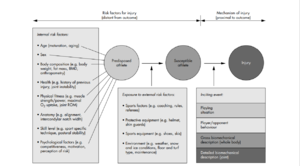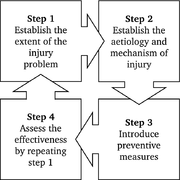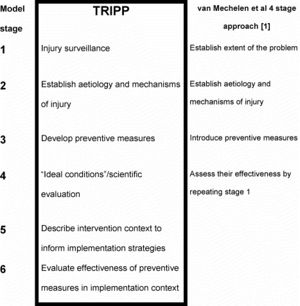Risk Factors and Injury Mechanisms in Sports Injuries
This article is currently under review and may not be up to date. Please come back soon to see the finished work! (6/04/2022)
Original Editor - Wanda van Niekerk
Top Contributors - Wanda van Niekerk, Jess Bell, Kim Jackson and Lucinda hampton
Introduction[edit | edit source]
Musculoskeletal injuries are common among athletes of all levels. The nature of these injuries vary among different sports, but the majority of these injuries are often as a result of a combination of factors and it is sometimes difficult to establish the specific mechanism that leads to injury.[1] Epidemiological studies in sports show that the rate of injury in athletes varies from 10%-65%[2][3] and for this reason, one of the main goals of sports physiotherapists and other professionals in sports is to prevent injury.[4]A key step in evidence-based injury prevention is to identify possible risk factors for injury.[5] Intrinsic risk factors such as strength, balance, joint mobility, biomechanics are often of interest as these are modifiable, whereas extrinsic risk factors such as age and previous injury are non-modifiable.[6] Understanding modifiable risk factors is necessary for the design of effective targeted risk mitigation strategies.[5]This may lead to the development of accurate and reliable tests to investigate risk factors, which is a necessary tool for athlete screening, monitoring of athletes over time and determine the efficacy of injury prevention programmes.[7]
Risk Factors[edit | edit source]
Bahr and Krosshaug[8] (2005) described risk factors for injury and mechanisms of injury. Internal risk factors that may predispose an athlete can include:
- Age
- Biological sex
- Body composition
- Health
- Physical fitness
- Anatomy
- Skill level
- Psychological factors
With the exposure to external risk factors, the athlete then becomes susceptible to injury. External risk factors include:
- Sports factors
- Protective equipment
- Environment
With the occurrence of an inciting event, the athlete is injured. Examples of inciting events are:
- Playing situation
- Player/opponent behaviour
- Gross biomechanical description (whole body)
- Detailed biomechanical description (joint)

Meeuwisse et al (2007)[1]focused on the intrinsic and extrinsic risk factors for injury and developed a dynamic, recursive model of aetiology in sports injury. This injury prevention model from Meeuwisse et al (2007)[1] highlights the fact that “adaptations occur within the context of sport (both in the presence and absence of injury) that alter risk and affect aetiology in a dynamic, recursive fashion.”[1] It is suggested that one should look further than the initial risk factors preceding an injury and consider how these risk factors may have changed during various cycles of training or participation. (https://www.physio-pedia.com/Risk_Factors_and_Injury_Mechanisms_in_Sports_Injuries)
Add image form Meeuwisse 2007 with reference
It is evident that there are multiple factors involved in the risk of injury occurrence and the interaction between these factors may increase the risk. These factors are:
There are various factors that play a role in the risk of injury occurrence, and these factors can interact with each other:[13]
Training-related factors
Training volume, load, intensity
Type of training
Training and competition schedule
Rest
Motor control factors
Posture
Movement patterns
Muscle tone
Technique
Sport specific movements
Psychological factors
Beliefs
Fears
Coping strategies
Self-efficacy
Catastrophising
Emotional status (stress, depression, anxiety)
Health-related factors
Diet
Medication
General health
Fatigue
Sleep patterns
Non-modifiable factors
Gender
Age
Maturation stage
Body type
Genetics
Previous injuries
Environmental factors
Training/competition surface
Equipment
Clothing
Weather
Coaching
Conditioning factors
Strength
Endurance
Muscle length
Joint range of motion
Chronic capacity
Additional demands
Home
Work
Family
Social
Leadership
Media
Sponsors
Other factors
Sport specific skill level
Ranking and status
Goals of athlete – short- and long-term https://www.physio-pedia.com/Musculoskeletal_Injury_Risk_Screening)
Sports Injury Prevention Models[edit | edit source]
Van Mechelen (1992)[10] developed the fundamental, conceptual model for the prevention of sports injuries, which has since been developed and further adapted in relation to many sports and specific types of injuries. The four steps of action in this model are:
- Identification of the magnitude of the problem (prevalence and incidence of injuries)
- Identification of the cause and mechanism of injury
- Development and implementation of an injury prevention strategy
- Evaluation of the effectiveness of the intervention
Meeuwisse et al (2007)[1]focused on the intrinsic and extrinsic risk factors for injury and developed a dynamic, recursive model of aetiology in sports injury. This injury prevention model from Meeuwisse et al (2007)[1] highlights the fact that “adaptations occur within the context of sport (both in the presence and absence of injury) that alter risk and affect aetiology in a dynamic, recursive fashion.”[1] It is suggested that one should look further than the initial risk factors preceding an injury and consider how these risk factors may have changed during various cycles of training or participation.
The TRIPP model by Finch (2006)[11] considered the context of interventions and behavioral features of athletes and sports professionals.
See also: Injury Prevention in Sport
Risk Factors and Injury Mechanisms[edit | edit source]
Injury Causation Model[edit | edit source]
Sports physiotherapists and other sports professionals recognise that the identification of the causes of injury is an important step in injury prevention as this can lead to the development of effective injury prevention programs. A model originally described by Meeuwisse (1994)[12] and adapted and expanded upon by Barr and Krosshaug (2005)[8] may guide sports professionals. It is important for sports professionals to know why certain athletes may be at risk of injury risk factors and how injuries occur (injury mechanism), in order to understand the causes of sports injuries. Sports injuries are rarely the result of a single factor, and can generally be attributed to an association of circumstances. Also, keep in mind that an athlete's risk of injury is not a constant and is likely to change over time.[13]
Risk Factors[edit | edit source]
Risk factors can be divided into intrinsic and extrinsic risk factors as well as modifiable and non-modifiable factors.
Intrinsic Risk Factors[edit | edit source]
Internal risk factors can be modifiable or non-modifiable. Modifiable factors such as skill level or fitness levels may be addressed through specific training methods. Non-modifiable factors such as sex may be used to create target interventions for athlete populations at an increased risk (think about female athletes with an increased risk for ACL injuries) These internal risk factors may include[8]:
- Age (maturation, ageing)
- Sex
- Body composition (e.g. body weight, fat mass, BMI, anthropometry)
- Fitness level (e.g. muscle strength/power, VO2 max, joint ROM)
- Health (previous injury, joint instability)
- Anatomy (alignment, intercondylar notch width)
- Skill level (e.g. sports-specific technique, postural stability)
- Psychological factors (e.g. competitiveness, motivation, perception of risk)
Extrinsic Risk Factors[edit | edit source]
These factors include the external factors that athletes are exposed to and include[8]:
- Human factors (e.g. teammates, opponents)
- Sports factors (e.g. coaching, rules, referees)
- Protective equipment (e.g. helmet, mouth guard, shin guards)
- Sports equipment (e.g. shoes, ski's, racquets)
- Environmental factors (e.g. weather, snow and ice conditions, floor and turf type, maintenance of playing surface)
Interaction between the intrinsic and extrinsic risk factors may cause an athlete to be more or less susceptible to injury. A combination of external and internal risk factors acting simultaneously puts an athlete at a higher risk for injury.
Injury Mechanisms[edit | edit source]
Injury mechanism can also be referred to as the “inciting event.” From a biomechanical perspective, considering tissue properties and load characteristics, an injury will be the result of the transfer of energy to tissue and the mechanical load will be in excess of the tissue's load tolerance. This is different for each type of tissue and is dependent on the type of load, the rate of load, the frequency of load and the magnitude of the load. Key points to remember when considering the biomechanical perspective is that biomechanics must explain how the injury is a result of mechanical load in excess of the tissue's loadbearing tolerance or how the mechanical load has reduced the tissue's tolerance level to a point where normal mechanical loads cannot be tolerated.[8]
When considering an epidemiological model, load and load tolerance is influenced by the main elements of the model - the intrinsic risk factors, the extrinsic risk factors and the inciting event.
It is important to have a precise description of the injury mechanism or "inciting event". This information may be used to develop specific injury prevention measures for specific types of injuries and even for specific sports. The description of the injury mechanism may include information on different levels. These levels may include[8]:
- Sports situation
- team action
- skills performed before and at point of injury
- player position
- court position
- Athlete behaviour
- player performance
- opponent interaction
- Whole body biomechanics
- description of whole-body kinematics and kinetics
- Joint/tissue biomechanics
- description of joint/tissue kinematics
Sports physiotherapists and sports professionals should know that each injury type has its typical patterns and the same for sports. Staying informed through keeping up with evidence-based literature is important for professionals working with athletes in all specific sports.
References[edit | edit source]
- ↑ 1.0 1.1 1.2 1.3 Meeuwisse WH, Tyreman H, Hagel B, Emery C. A dynamic model of etiology in sport injury: the recursive nature of risk and causation. Clin J Sport Med. 2007;17(3):215–219.
- ↑ Alonso JM, Junge A, Renstrom P, Engebretsen L, Mountjoy M, Dvorak J. Sports injuries surveillance during the 2007 IAAF World Athletics Championships. Clin J Sport Med. 2009;19(1):26–32.
- ↑ Junge A, Engebretsen L, Mountjoy ML, Alonso JM, Renstrom PA, Aubry MJ, et al. Sports injuries during the Summer Olympic Games 2008. Am J Sports Med. 2009;37(11):2165–2172.
- ↑ Saragiotto BT, Di Pierro C, Lopes AD. Risk factors and injury prevention in elite athletes: a descriptive study of the opinions of physical therapists, doctors and trainers. Braz J Phys Ther. 2014;18(2):137–143.
- ↑ 5.0 5.1 Collings TJ, Bourne MN, Barrett RS, du Moulin W, Hickey JT, Diamond LE. Risk factors for lower limb injury in female team field and court sports: a systematic review, meta-analysis, and best evidence synthesis. Sports Medicine. 2021 Apr;51(4):759-76.
- ↑ Fulton J, Wright K, Kelly M, Zebrosky B, Zanis M, Drvol C, Butler R. Injury risk is altered by previous injury: a systematic review of the literature and presentation of causative neuromuscular factors. International journal of sports physical therapy. 2014 Oct;9(5):583.
- ↑ Verhagen E, van Dyk N, Clark N, Shrier I. Do not throw the baby out with the bathwater; screening can identify meaningful risk factors for sports injuries. British journal of sports medicine. 2018 Oct 1;52(19):1223-4.
- ↑ 8.0 8.1 8.2 8.3 8.4 8.5 Bahr R, Krosshaug T. Understanding injury mechanisms: a key component of preventing injuries in sport. Br J Sports Med 2005: 39: 324-329.
- ↑ Bahr R, Krosshaug T. Understanding injury mechanisms: a key component of preventing injuries in sport. Br J Sports Med 2005: 39: 324-329.
- ↑ Van Mechelen W, Hlobil H, Kemper HC. Incidence, severity, aetiology and prevention of sports injuries. A review of concepts. Sports Med. 1992;14(2):82–99
- ↑ Finch C. A new framework for research leading to sports injury prevention. J Sci Med Sport. 2006;9(1-2):3–9.
- ↑ Meeuwisse W. Assessing causation in sports injury: A multifactorial model. Clin J Sport Med 1994:4: 66-170.
- ↑ Theisen D, Malisoux L, Seil R, Urhausen A. Injuries in youth sports: epidemiology, risk factors and prevention. Deutsche Zeitschrift für Sportmedizin. 2014 Sep 1;65(9):248-52.









